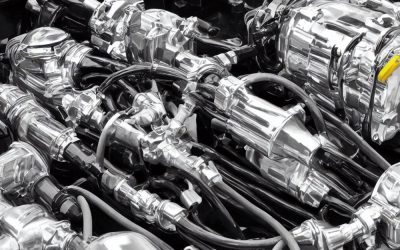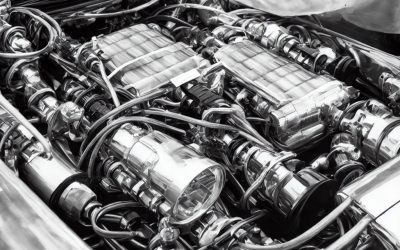American Muscle Cars Use Fuel Injection: The Modern Technology Behind Classic Power
American muscle cars have been a symbol of power and speed for many decades. These vehicles are known for their high-performance engines and aggressive designs. The fuel injection system is a critical component that makes these cars so powerful.
Fuel injection technology has been used in American muscle cars for many years. It replaced the carburetor as the primary means of fuel delivery in the 1980s. Fuel injection systems are designed to deliver fuel directly into the engine’s combustion chamber, resulting in better fuel efficiency and more power. This technology has dramatically improved the performance of American muscle cars, making them faster and more reliable.
Evolution of Fuel Injection in American Muscle Cars
Fuel injection has been a significant part of American muscle cars since the 1980s. It replaced the carburetor system, which was inefficient and caused problems with emissions control. Fuel injection systems have become more efficient and reliable, resulting in better performance and fuel economy.
The first fuel injection system used in American muscle cars was the TBI (Throttle Body Injection) system. It was introduced in 1981 by General Motors and was used in the Chevrolet Camaro and Pontiac Firebird. The TBI system was a basic system that used a single injector mounted on top of the throttle body. It was a simple system that provided better fuel economy and reduced emissions.
In the late 1980s, American muscle cars started using the more advanced Multi-Port Fuel Injection (MPFI) system. The MPFI system used multiple injectors for each cylinder to deliver fuel directly into the combustion chamber. This system provided better performance and fuel economy than the TBI system.
In the 1990s, American muscle cars started using Sequential Fuel Injection (SFI) systems. The SFI system used sensors to determine the exact amount of fuel needed for each cylinder, resulting in even better performance and fuel economy.
Today, American muscle cars use advanced fuel injection systems that are more efficient and reliable than ever before. These systems use advanced sensors and computer controls to deliver the right amount of fuel at the right time, resulting in improved performance and fuel economy.
In conclusion, fuel injection has come a long way since its introduction in American muscle cars. It has evolved from basic TBI systems to advanced SFI systems, resulting in better performance, fuel economy, and emissions control.
Technological Advancements in Fuel Injection Systems
Electronic Fuel Injection
Electronic fuel injection (EFI) is a fuel injection system that uses electronic controls to regulate the amount of fuel delivered to the engine. EFI systems have replaced carburetors in most modern vehicles due to their superior performance and efficiency.
One of the critical advantages of EFI systems is their ability to control the fuel-to-air ratio in the engine precisely. This results in better fuel economy, lower emissions, and improved overall performance. EFI systems also allow for better cold-start performance and faster warm-up times.
EFI systems use a variety of sensors to monitor engine conditions and adjust fuel delivery accordingly. These sensors include mass airflow sensors, oxygen sensors, and throttle position sensors. This data is processed by the engine control module (ECM), which determines the optimal fuel delivery for the engine.
Direct Fuel Injection
Direct fuel injection (DFI) is a type of fuel injection system that delivers fuel directly into the engine’s combustion chamber. DFI allows for even greater control over the fuel-to-air ratio, resulting in improved performance and efficiency.
DFI systems use high-pressure injectors to deliver fuel directly into the combustion chamber. DFI allows for more precise control of fuel delivery, resulting in better combustion and improved power output. DFI systems also allow for better management of emissions, as they can more effectively regulate the amount of fuel delivered to the engine.
One of the critical advantages of DFI systems is their ability to reduce engine knock. Engine knock occurs when the air-fuel mixture in the engine detonates prematurely, causing a knocking sound and potentially damaging the engine. DFI systems can prevent engine knock by precisely controlling the fuel-to-air ratio and reducing the likelihood of premature detonation.
In conclusion, electronic and direct fuel injection are two critical technological advancements in fuel injection systems. These systems offer superior performance, efficiency, and control over traditional carburetors, making them a popular choice for modern vehicles.
Comparison: Carburetor vs. Fuel Injection
Regarding American muscle cars, the debate between carburetors and fuel injection systems is a hot topic. While carburetors have been the traditional choice for many years, fuel injection has recently become increasingly popular. Here’s a brief comparison of the two systems:
Carburetor
Carburetors are mechanical devices that mix air and fuel to create an explosive mixture for the engine. They use a series of valves and jets to regulate fuel flow into the machine. Carburetors are relatively simple and inexpensive, making them popular among muscle car enthusiasts.
However, carburetors have some drawbacks. They are less efficient than fuel injection systems and can be challenging to tune and adjust. Additionally, carburetors are more prone to flooding and stalling, especially in cold weather.
Fuel Injection
On the other hand, fuel injection systems use electronic sensors and injectors to control the amount of fuel delivered to the engine precisely. This results in more efficient combustion and better overall performance. Fuel injection systems are also more reliable and more accessible to tune than carburetors.
However, fuel injection systems are more complex and expensive than carburetors. They require more advanced technology and specialized knowledge to install and maintain. Additionally, fuel injection systems can be more challenging to diagnose and repair if something goes wrong.
In conclusion, carburetors and fuel injection systems have pros and cons. Ultimately, the choice between the two comes down to personal preference and the vehicle’s specific needs.
Impact of Fuel Injection on Performance
Efficiency
The implementation of fuel injection in American muscle cars has had a significant impact on efficiency. Fuel injection systems deliver fuel to the engine more precisely, resulting in better fuel economy. The fuel injection system controls the energy injected into the machine based on the engine’s needs. This precision allows for a more efficient combustion process, reducing fuel consumption and emissions.
Power
Fuel injection systems have also had a positive impact on power output. Fuel injection systems can deliver fuel more precisely and consistently than carburetors, which results in a more efficient combustion process. This efficiency can increase horsepower and torque, which is especially important in high-performance applications. Fuel injection systems can also be tuned to deliver fuel at specific engine speeds, improving throttle response.
Reliability
Fuel injection systems have improved the reliability of American muscle cars. Carburetors are prone to flooding, vapor lock, and clogged jets, leading to poor performance and engine damage. Fuel injection systems are less prone to these issues and are more reliable overall. Additionally, fuel injection systems can be self-diagnosing, which can help identify issues before they become significant problems.
In summary, implementing fuel injection in American muscle cars has significantly impacted efficiency, power, and reliability. Fuel injection systems deliver fuel more precisely, resulting in better fuel economy, increased power output, and improved reliability. As a result, fuel injection has become the standard for high-performance American muscle cars.
Environmental Implications of Fuel Injection
Fuel injection has significantly developed in the automotive industry, especially in American muscle cars. However, it has environmental implications that cannot be ignored. This section will explore the various environmental impacts of fuel injection.
Reduced Emissions
One of the significant benefits of fuel injection is that it reduces emissions. Fuel injection systems are designed to deliver the right fuel to the engine, ensuring that combustion is efficient and complete. Injection means that less fuel is wasted, resulting in fewer emissions. Additionally, fuel injection systems are equipped with sensors that monitor the engine’s performance and adjust the fuel delivery accordingly, further reducing emissions.
Improved Fuel Economy
Fuel injection systems also improve fuel economy. Since the systems deliver the right amount of fuel to the engine, there is less waste, resulting in better fuel efficiency. American muscle cars with fuel injection systems use less energy, reducing their carbon footprint.
Reduced Carbon Footprint
The reduced emissions and improved fuel economy of fuel injection systems result in a reduced carbon footprint. American muscle cars with fuel injection systems emit fewer greenhouse gases and use less fuel, making them more environmentally friendly.
Proper Maintenance is Key
While fuel injection systems have many environmental benefits, they require proper maintenance to function optimally. A poorly maintained fuel injection system can lead to increased emissions and reduced fuel economy, negating the environmental benefits. It is essential to ensure that the fuel injection system is regularly inspected and maintained to keep it running efficiently.
In conclusion, fuel injection has significant environmental implications for American muscle cars. It reduces emissions, improves fuel economy, and reduces the carbon footprint. However, proper maintenance is crucial to ensure that the system functions optimally and continues to provide environmental benefits.
Future of Fuel Injection in American Muscle Cars
As technology advances, so does the future of fuel injection in American muscle cars. Fuel injection has become increasingly popular in recent years due to its efficiency and ability to provide more precise fuel delivery. In the past, carburetors were the go-to method for fuel delivery in American muscle cars. Still, fuel injection has now become the norm.
One potential future for fuel injection in American muscle cars is direct injection. Direct injection allows for more precise fuel delivery, improving fuel efficiency and power output. This technology is already being used in some high-performance vehicles. It is likely to become more common in American muscle cars in the future.
Another potential future for fuel injection in American muscle cars is hybrid technology. Hybrid technology combines a gasoline engine with an electric motor, improving fuel efficiency and reducing emissions. As the demand for more environmentally friendly vehicles increases, American muscle cars will likely begin incorporating hybrid technology into their designs.
Overall, the future of fuel injection in American muscle cars looks bright. With continued advancements in technology, we can expect to see even more efficient and powerful engines that are also environmentally friendly.



